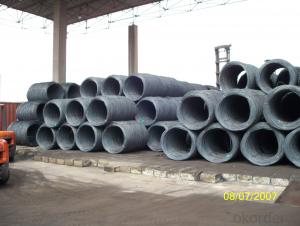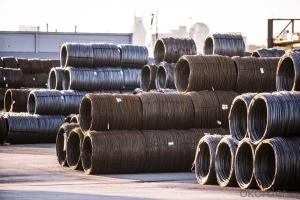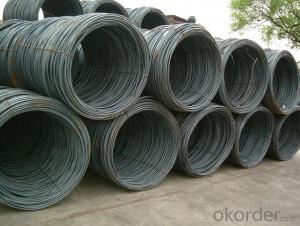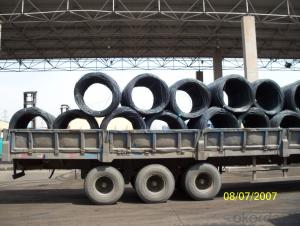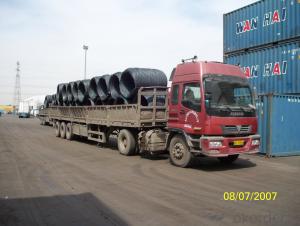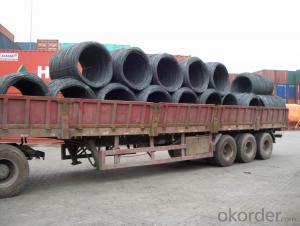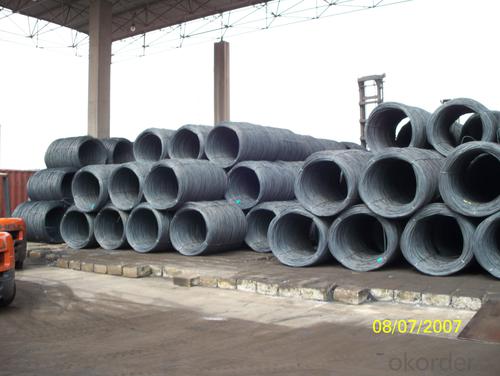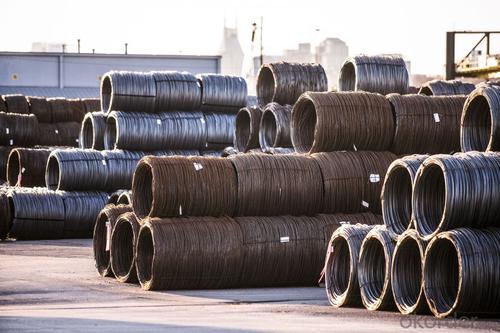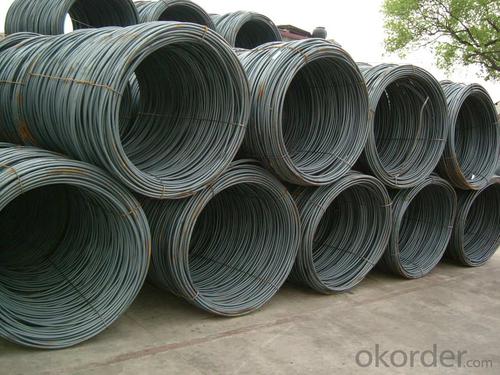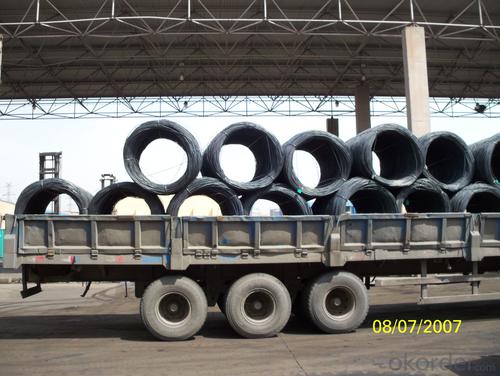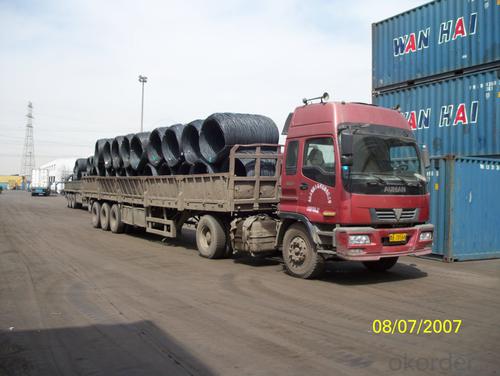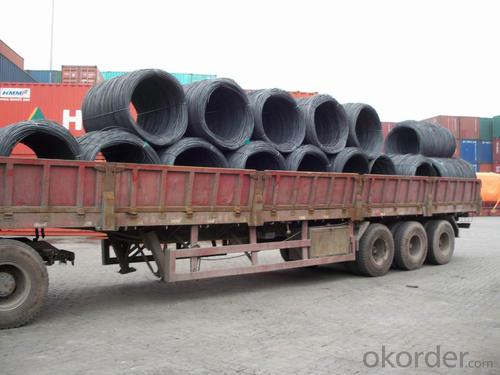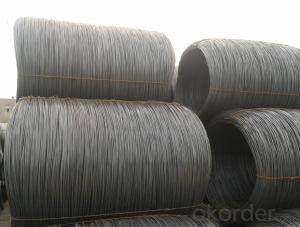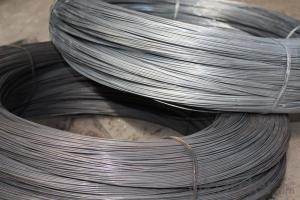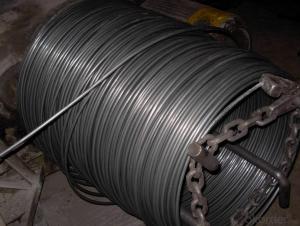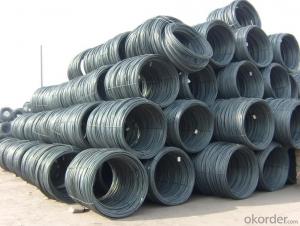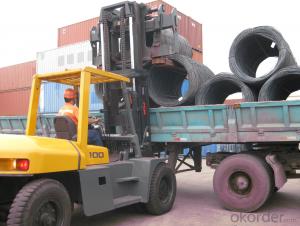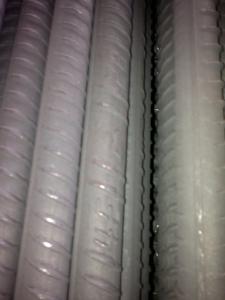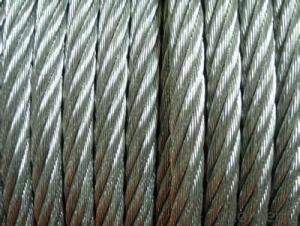SAE1006Cr Carbon Steel Wire Rod 6mm for Welding
- Loading Port:
- Shanghai
- Payment Terms:
- TT OR LC
- Min Order Qty:
- 100 m.t
- Supply Capability:
- 30000 m.t/month
OKorder Service Pledge
OKorder Financial Service
You Might Also Like
Specification
Description of SAE1006Cr Carbon Steel Wire Rod 6mm for Welding:
OKorder is offering Color Coated Steel Coil Prepainted Steel Coil at great prices with worldwide shipping. Our supplier is a world-class manufacturer of steel, with our products utilized the world over. OKorder annually supplies products to European, North American and Asian markets. We provide quotations within 24 hours of receiving an inquiry and guarantee competitive prices.
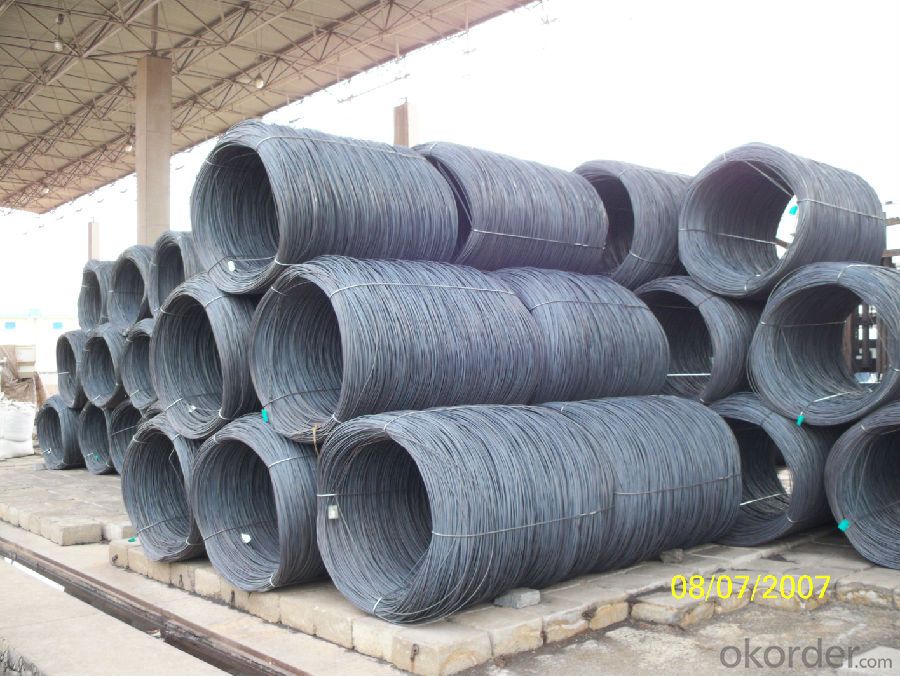
Applications of SAE1006Cr Carbon Steel Wire Rod 6mm for Welding:
Color Coated Steel Coil Prepainted Steel Coil are ideal for structural applications and are widely used in the construction of buildings and bridges, and the manufacturing, petrochemical, and transportation industries.
Main Product Features of SAE1006Cr Carbon Steel Wire Rod 6mm for Welding:
· Premium quality
· Prompt delivery & seaworthy packing (30 days after receiving deposit)
· Corrosion resistance
· Can be recycled and reused
· Mill test certification
· Professional Service
· Competitive pricing
Specifications of SAE1006Cr Carbon Steel Wire Rod 6mm for Welding:
PPGI:
1, Introduction: Color coated steel coils(sheets), i. E. PPGI, also called prepainted steel coils(sheets), are made of galvanized steel coils(sheets) with polymer coatings as surface. It's a new enclosure material and building board with characteristics of light-weighted, heat preserved&insulated, easily installed with bright colors.
2, Production Process: Pretreatment(Degreasing)_Drying_Chromating_Paint Basic Oil_Cooling_Drying_Color Coating_Cooling_Film-covering_Rolling Up
3, Characteristics:
Good at corrosion resistence. Besides zinc coating of the basic plate of galvanized steel sheet, the color coating as the surface has double lifetime to ensure better anticorrosion effect.
With excellent cold bending molded manufacturablity, PPGI products can be processed or directly used as final product. As being light-weighted and conveniently transported, they're widly used to replace wood to save energy.
There're thousands of colors can be chosen as per different application. Any color plays well in decoration.
No pollution with high recycling rate, PPGI coils and sheets are strongly recommended as enviroment-friendly products by the government.
5, eye bands and 4 circumferential bands in steel, galvanized metal fluted rings on inner and outer edges, galvanized.
| commodity | SAE1006Cr Carbon Steel Wire Rod 6mm for Welding |
| Techinical Standard: | JIS G3302-1998, EN10142/10137, ASTM A755 |
| grade | Q195,Q215,Q235,SAE1006,SAE1008 SAE1006Cr |
| Types: | Mesh welding |
| Base metal | galvanized, galvalume, cold rolled steel |
| Thickness | 0.14-1.0mm(0.16-0.8mm is the most advantage thickness) |
| Width | 610/724/820/914/1000/1200/1219/1220/1250mm |
| Type of coating: | PE, SMP, PVDF |
| Zinc coating | Z60-150g/m2 or AZ40-100g/m2 |
| Top painting: | 5 mic. Primer + 15 mc. R. M. P. |
| Back painting: | 5-7 mic. EP |
| Color: | According to RAL standard |
| ID coil | 508mm610mm |
| Coil weight: | 2--3MT |
| Package: | Properly packed for ocean freight exportation in 20'containers |
| Application: | Industrial panels, roofing and siding for painting/automobile |
| Price terms | FOB, CFR, CIF |
| Payment terms | 20%TT in advance+80% TT or irrevocable 80%L/C at sight |
| delivery time | 25 days after recepit of 20% TT |
| Remarks | Insurance is all risks |
| MTC 3.1 will be handed on with shipping documents | |
| We accept SGS certificatation test |
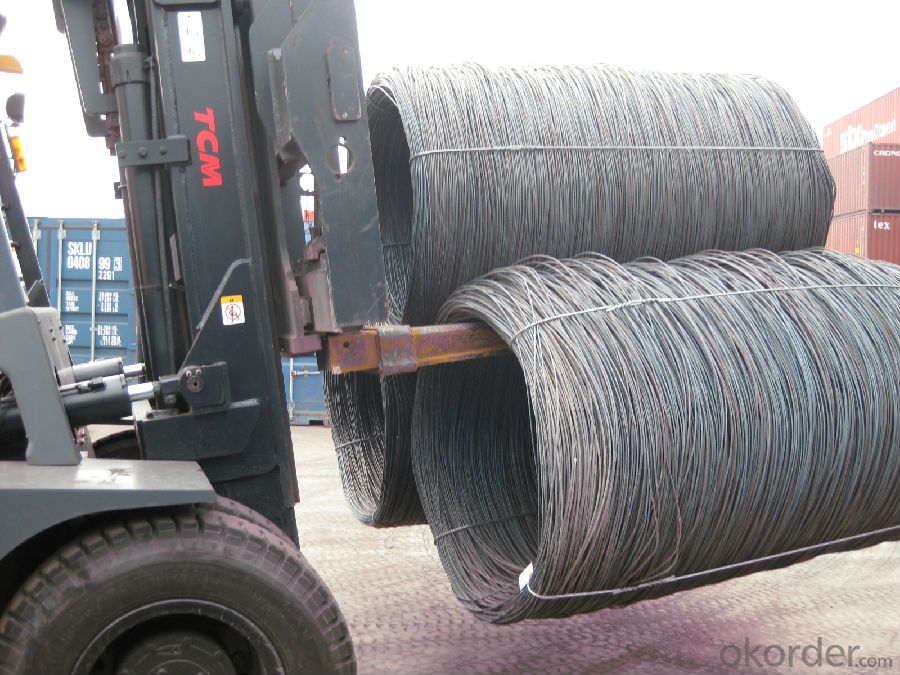
FAQ of SAE1006Cr Carbon Steel Wire Rod 6mm for Welding:
Q1: Why buy Materials & Equipment from OKorder.com?
A1: All products offered byOKorder.com are carefully selected from China's most reliable manufacturing enterprises. Through its ISO certifications, OKorder.com adheres to the highest standards and a commitment to supply chain safety and customer satisfaction.
Q2: How do we guarantee the quality of our products?
A2: We have established an advanced quality management system which conducts strict quality tests at every step, from raw materials to the final product. At the same time, we provide extensive follow-up service assurances as required.
Q3: How soon can we receive the product after purchase?
A3: Within three days of placing an order, we will begin production. The specific shipping date is dependent upon international and government factors, but is typically 7 to 10 workdays.
Q4: What makes stainless steel stainless?
A4: Stainless steel must contain at least 10.5 % chromium. It is this element that reacts with the oxygen in the air to form a complex chrome-oxide surface layer that is invisible but strong enough to prevent further oxygen from "staining" (rusting) the surface. Higher levels of chromium and the addition of other alloying elements such as nickel and molybdenum enhance this surface layer and improve the corrosion resistance of the stainless material.
Q5: Can stainless steel rust?
A5: Stainless does not "rust" as you think of regular steel rusting with a red oxide on the surface that flakes off. If you see red rust it is probably due to some iron particles that have contaminated the surface of the stainless steel and it is these iron particles that are rusting. Look at the source of the rusting and see if you can remove it from the surface.
- Q: What are the growth prospects for the steel wire rod market?
- The growth prospects for the steel wire rod market are positive due to increasing demand from various industries such as construction, automotive, and manufacturing. Additionally, the growing infrastructure development in emerging economies and the need for advanced and high-strength materials are expected to further drive the market growth.
- Q: How does the electrical conductivity of steel wire rod vary with different grades?
- Differences in the composition and microstructure of steel lead to variations in the electrical conductivity of steel wire rod across different grades. Typically, steel wire rod is produced using carbon steel, an alloy of iron and carbon. However, the electrical conductivity can be influenced by the presence of other elements like manganese, silicon, and various alloying elements, which vary in quantity among different grades of steel. In general, higher carbon content in steel diminishes its electrical conductivity. This occurs because carbon atoms obstruct the movement of electrons, making it more challenging for electricity to flow through the material. Moreover, the existence of impurities or other alloying elements also affects the electrical conductivity of steel wire rod. For instance, elements such as phosphorus, sulfur, and oxygen introduce impurities that hinder electron flow, thereby decreasing conductivity. Furthermore, the microstructure of steel, including the presence of grain boundaries, also impacts electrical conductivity. Grain boundaries act as barriers to electron flow, ultimately reducing conductivity. Hence, when assessing the electrical conductivity of steel wire rod, it is crucial to consider the specific grade. Varied carbon content, impurities, and microstructural attributes all contribute to the disparities in electrical conductivity among different grades of steel wire rod.
- Q: What are the different fatigue testing methods for steel wire rod?
- There are several fatigue testing methods for steel wire rods, including rotating bending fatigue tests, axial fatigue tests, torsional fatigue tests, and fretting fatigue tests. Each method has its own advantages and is used to evaluate the fatigue performance of steel wire rods under different loading conditions.
- Q: What are the main factors affecting the product innovation of steel wire rod?
- The main factors affecting the product innovation of steel wire rod include technological advancements, market demand, competition, government regulations, and environmental sustainability. Technological advancements play a crucial role in enhancing the quality, strength, and durability of steel wire rod. Market demand and competition drive manufacturers to continuously innovate and develop new products to meet customer needs and stay ahead in the market. Government regulations, such as safety standards and environmental regulations, also influence product innovation by setting requirements and guidelines that manufacturers must adhere to. Lastly, the focus on environmental sustainability has prompted the steel industry to develop innovative and eco-friendly products and processes, leading to further innovation in steel wire rod.
- Q: How is steel wire rod used in the manufacturing of wire rope clamps?
- Steel wire rod is used in the manufacturing of wire rope clamps as it serves as the raw material for creating the clamps' sturdy and durable structure. The steel wire rod is typically formed, shaped, and manipulated into the desired clamp design, providing the necessary strength and reliability to secure the wire rope in place.
- Q: How is steel wire rod heat treated to improve its mechanical properties?
- In order to enhance its mechanical properties, such as strength, hardness, and ductility, steel wire rod undergoes heat treatment. This involves a carefully controlled series of heating and cooling steps. The initial step in heat treating steel wire rod is annealing. This entails heating the steel to a specific temperature, usually above its critical temperature, and then allowing it to gradually cool. Annealing helps to relieve internal stresses and create a consistent microstructure, resulting in improved ductility and toughness. Following annealing, the steel wire rod may be subjected to quenching. This involves rapidly cooling the heated steel by immersing it in a liquid, like oil or water. This rapid cooling alters the microstructure of the steel, yielding a hard but brittle material. However, the steel becomes more prone to cracking and distortion. To counteract the brittleness caused by quenching, tempering is often employed. This process includes reheating the quenched steel to a lower temperature and then allowing it to cool slowly. This controlled cooling enables the steel to partially regain its ductility and toughness while maintaining some of its hardness. The specific temperature and duration of tempering can be adjusted to achieve the desired balance of mechanical properties. Depending on the specific requirements of the steel wire rod, other heat treatment processes such as normalization or case hardening may also be utilized. Normalization is similar to annealing but involves cooling the steel in still air, while case hardening involves adding a layer of harder material to the surface of the steel. Overall, the heat treatment of steel wire rod is a crucial step in enhancing its mechanical properties. By precisely controlling the heating and cooling processes, the steel can be transformed into a material that possesses the desired combination of strength, hardness, and ductility.
- Q: What are the standard cleanliness requirements for steel wire rod?
- The standard cleanliness requirements for steel wire rod typically include the absence of surface defects such as scale, rust, or pitting. It should also be free from any contaminants like dirt, oil, or grease. Additionally, the wire rod should meet specific chemical composition and mechanical properties as per industry standards or customer specifications.
- Q: How is steel wire rod used in the manufacturing of cables and wires?
- Steel wire rod is an essential component in the manufacturing of cables and wires due to its exceptional strength and durability. It serves as the base material for the production of various types of cables and wires used in a wide range of industries. In the manufacturing process, steel wire rod is first drawn through a series of dies to reduce its diameter and increase its length. This process, known as wire drawing, helps to refine the steel wire rod and improve its mechanical properties. The wire is then subjected to various treatments such as annealing or heat treatment to further enhance its strength and flexibility. Once the steel wire rod has been properly processed, it is ready to be used in the production of cables and wires. The wire is typically coated with materials such as plastic or rubber to provide insulation and protection against moisture, chemicals, and other external factors. This coating also helps to improve the overall performance and longevity of the cables and wires. Steel wire rod is used in the manufacturing of a wide range of cables and wires, including electrical cables, communication cables, and structural cables. Electrical cables, for example, are used to transmit electricity and are commonly found in power grids, buildings, and appliances. Communication cables, on the other hand, are used for data transmission and are widely used in telecommunications and networking systems. In addition to its strength and durability, steel wire rod offers excellent conductivity, making it an ideal choice for applications that require efficient electrical or data transmission. It is also cost-effective compared to other materials, making it a popular choice for cable and wire manufacturers. Overall, steel wire rod plays a crucial role in the manufacturing of cables and wires, providing the strength, durability, and conductivity required for various applications. Its versatility and reliability make it an indispensable component in the production of high-quality cables and wires used in various industries.
- Q: How are steel wire rods used in the manufacturing of piano strings for musical instruments?
- Piano strings rely on steel wire rods as a key component in their production. These rods, crafted from top-notch steel, are carefully engineered to possess the desired properties for piano strings. To begin the process, the steel wire rods are drawn through a set of dies. This action reduces their diameter while simultaneously increasing their tensile strength. This wire drawing process guarantees that the steel wire rods are sturdy enough to endure the tension necessary for piano strings. After reaching the desired size, the steel wire rods undergo further processing to form individual piano strings. The wire is cut into specific lengths and coiled to achieve the desired shape and size for each string. These coils are then wrapped around a core wire, which adds stability and enhances the tonal quality of the string. The utilization of steel wire rods in piano string manufacturing holds immense importance for several reasons. Firstly, steel is renowned for its durability and resistance to stretching, making it an ideal choice for withstanding the constant tension and pressure exerted on piano strings. Additionally, steel wire rods possess outstanding flexibility, allowing the strings to vibrate freely and produce a rich and resonant sound. Moreover, the precise manufacturing process of steel wire rods guarantees that the resulting piano strings maintain consistent quality and uniformity. This aspect is crucial for preserving the integrity and balance of sound across the entire piano keyboard. In conclusion, the role of steel wire rods in piano string manufacturing cannot be overstated. Their strength, flexibility, and precision make them the perfect material for producing high-quality strings that can meet the demanding requirements of a piano.
- Q: How does the corrosion resistance of steel wire rod vary with different surface treatments?
- Different surface treatments can greatly affect the corrosion resistance of steel wire rod. These treatments are used to improve the wire rod's ability to withstand corrosion and extend its lifespan. One common treatment for steel wire rod is galvanization, which involves applying a layer of zinc to the surface. This zinc coating acts as a sacrificial barrier, protecting the steel underneath from corrosion. Galvanized steel wire rod offers excellent corrosion resistance and can endure harsh conditions like high humidity or corrosive chemicals. Phosphating is another treatment option for steel wire rod. It entails applying a phosphate coating to the surface, enhancing its resistance to corrosion. This coating forms a protective layer, preventing rust formation and halting the spread of corrosion. Furthermore, steel wire rod can be coated with various substances, such as epoxy or polymers, to provide an additional layer of defense against corrosion. These coatings act as barriers, preventing moisture and corrosive substances from reaching the steel surface. Coated steel wire rod exhibits improved corrosion resistance and can be used in environments where direct exposure to moisture or corrosive agents is expected. It is important to note that the effectiveness of surface treatments in enhancing corrosion resistance can vary depending on specific conditions and the quality of the treatment. Factors like coating thickness and adhesion, presence of defects or impurities, and the type and concentration of corrosive substances in the environment can all impact the corrosion resistance of steel wire rod. In conclusion, the corrosion resistance of steel wire rod can be significantly improved through surface treatments like galvanization, phosphating, or the application of coatings. These treatments create protective barriers that ensure the wire rod's longevity and durability in different environments.
Send your message to us
SAE1006Cr Carbon Steel Wire Rod 6mm for Welding
- Loading Port:
- Shanghai
- Payment Terms:
- TT OR LC
- Min Order Qty:
- 100 m.t
- Supply Capability:
- 30000 m.t/month
OKorder Service Pledge
OKorder Financial Service
Similar products
Hot products
Hot Searches
Related keywords
